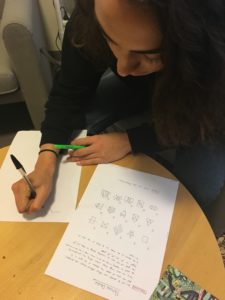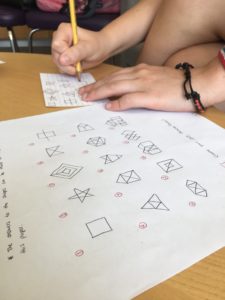DESCRIPTION OF THE GAME:
My play experience involved me counting up to 100 while a page is loading if there is a progress bar indicating the loading process. The game that I created from this play experience involves competing with a progress bar on the screen by getting as many taps as the player can on a screen. This game requires a minimum of two players with the player with the higher number of taps will win. If a single player is playing the game, then there is a mode in which the player has to set his best score in the first level and then in order to move on to the next level, the player has to beat his previous score. The player would be given three lives and if they are unable to set a new high score in those three chances, they will have to start over.
The essential component in both is competing with a progress bar. While the play experience was geared more towards letting the progress bar finish first, the game involves the player challenging the progress bar and recording as many taps as possible before the progress bar fills up.
SPACE APPROPRIATION
This game requires there to be a screen with a progress bar and to record the player’s taps (ideally they should both be on the same screen as during playtesting the player was initially a little uncomfortable in having to focus on two separate screens). The screen needs to be a touch-screen for the player can tap on. There should also be a second player to compete with however that is not necessary.
Apart from this, there is nothing else that the player need to play this game. As long as the player has a touch screen, they are good to go!
PLAYTESTING AND SUBSEQUENT CHANGES
The initial idea of the game was that the player has to cross a stipulated number of taps before the progress bar reaches 100% in order to progress to the next level. In order to pass the first level the player needs to cross 200 taps, 250 taps to cross the second level, 300 for the third level and so on. However, during playtesting the players felt that the first few levels were too easy and they didn’t find it challenging enough. Also, after crossing the level which required 350 taps it became extremely difficult to move on to the next level which caused frustration leading to the player giving up. Therefore, in theory I had many levels in the game but in practice only a few levels were challenging enough and pass-able. The rest were either too easy or too difficult to move on.
What I did notice during playtesting was that in the first few levels which did not require a lot of taps to be completed, the players would keep on tapping just to see what is the highest number of taps that they can achieve. This led me to create a modification in the game- instead of me providing the players with the required number of taps they would give themselves that number by setting up a best score in the first round. This led to a more engaging experience for the players as they were now trying to be better than themselves and had a more personal incentive to beat the game.
I got a chance to playtest the game during class and noticed that it was much more fun and challenging with the multiplayer mode. I also noticed that people were getting a little tired towards the end because the progress bar that I was working with took a minute to complete which is very long for one round. Therefore, the progress bar should definitely complete fast (about 30 seconds). Also, a lot of suggestions were made for the game to include ways in which one player can use the taps that they have accumulated till now to use against the opponent (eg. using 30 taps to freeze the other players screen for a few seconds, use 20 taps to reduce the other players taps etc.). I believe that these challenges will be very suitable to increase the engagement level and challenge level as well.


Video:
https://drive.google.com/file/d/1QDWb8ciea4RYEjlTavjEqw11Np3JQ0t7/view?usp=sharing
CREATION VS DESTRUCTION AND EXPRESSIVENESS
Playing the game invites creation of a feeling of competition and challenging yourself. While the initial version did not do so, the final version takes this into account which is a very important component in making the game engaging and fun. It fosters the quality of trying again and again to make yourself better than before. This is also how a player can be expressive- competing with yourself could be a way to express how you feel about challenging yourself and getting better than yourself. I believe that if a person is very hard working and is open to improving themselves, they will be much more engaged in this game than people who are not very focused on such qualities.
 Stuck in a rut? Can’t seem to concentrate on your work? Play Mult, a game tailored to the individual. Before beginning, identify your base task, such as doing your laundry, boiling water for tea, or microwaving food. If there is no base task, click the ‘Just for Fun’ option in the Mult mobile app and set the timer according to your needs.Using the app, create your to do list for the day and assign points to each task. These points should reflect your belief in the underlying difficulty of each task.
Stuck in a rut? Can’t seem to concentrate on your work? Play Mult, a game tailored to the individual. Before beginning, identify your base task, such as doing your laundry, boiling water for tea, or microwaving food. If there is no base task, click the ‘Just for Fun’ option in the Mult mobile app and set the timer according to your needs.Using the app, create your to do list for the day and assign points to each task. These points should reflect your belief in the underlying difficulty of each task.








